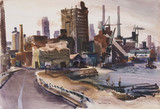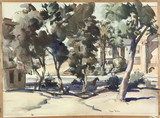Barse Miller was one of Southern California’s most important artists, contributing significantly to the development of the California watercolor school. At age eleven he began his studies at the National Academy of Design in New York, and during summers in the late 1910s he attended classes under Henry B. Snell (1858-1943) and HUGH H. BRECKENRIDGE in East Gloucester, Massachusetts. From Breckenridge he learned color theory and later, while attending the Pennsylvania Academy of the Fine Arts in Philadelphia, he studied with Breckenridge’s friend Arthur B. Carles (1882-1952). The Pennsylvania Academy twice awarded him traveling scholarships to Paris, where he was much impressed by the work of the French impressionists, in particular Edgar Degas (1834-1917), and of Henri Matisse (1860-1954). In 1923 Miller exhibited at the Salon d’Automne.
On his return to the United States he settled in California. Before World War II he taught at various schools, including the Art Center of Los Angeles; the Harwood Foundation in Taos, New Mexico, summers 1938-40; the University of Vermont at Burlington, summers 1939-40; and the Chester Springs School of the Pennsylvania Academy, summers 1940-41. He also executed murals, including ones for Sommer and Kaufmann’s Modern Store in San Francisco and for post offices in Island Point, Vermont, and Burbank, California. His first solo exhibition in the West was organized by the Los Angeles Museum in 1928, and his first in the East by the Ferargil Galleries in New York in 1936.
During the war Life magazine hired Miller to document the training of the armed forces, and his illustrations first appeared in the May 12, 1942, issue. During the war he served as chief of the Combat Art Section in the Pacific. His paintings and drawings of combat, later exhibited and reproduced, earned him the Legion of Merit. After the war he settled in New York, and in 1946 won a Guggenheim Fellowship. He taught at the Art Students League from 1947 to his death and at Queens College, serving as chairman of the art department, 1947-53. He continued to exhibit at Cowie Gallery in Los Angeles until 1967.
Since he was the son of a writer on outdoors subjects and of an artist, it is perhaps not surprising that Miller’s art was devoted to landscape painting. He also depicted figures in the American scene tradition, humorously at first. His views of the California countryside, coast, and cities set an example for generations of students before World War II. After his move east his images of Long Island took on a romantic mood. He worked in both oil and watercolor until 1948 and thereafter turned exclusively to watercolor.
BIBLIOGRAPHY
Archiv. Am. Art, Ferargil Galleries Papers, Barse Miller Scrapbook § Ernest W. Watson, "Barse Miller, Painter at the Crossroads: Interview," American Artist 10 (June 1946): 20-25 § Los Angeles, Cowie Wilshire Galleries, Barse Miller, NA., exh. cat., 1961, with essays by Rex Brandt and Alexander S. Cowie, biographical note, list of awards and collections § Moure 1975, pp. 20-22, 58, with bibliography § Moure with Smith 1975, pp. 168-69, with bibliography.

